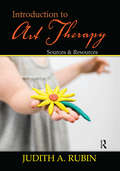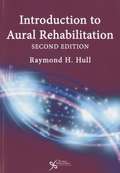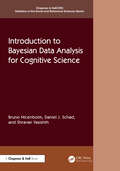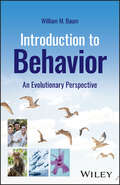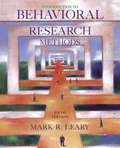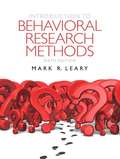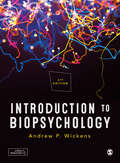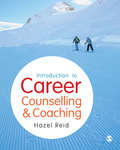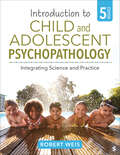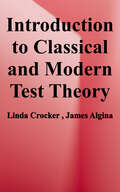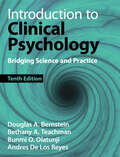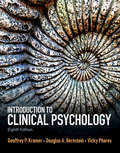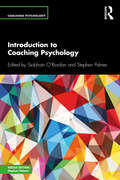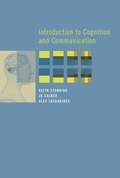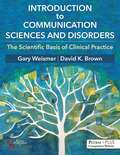- Table View
- List View
Introduction to Art Therapy: Sources & Resources
by Judith A. RubinIntroduction to Art Therapy: Sources and Resources, is the thoroughly updated and revised second edition of Judith Rubin’s landmark 1999 text, the first to describe the history of art in both assessment and therapy, and to clarify the differences between artists or teachers who provide "therapeutic" art activities, psychologists or social workers who request drawings, and those who are trained as art therapists to do a kind of work which is similar, but qualitatively different. This new edition contains a DVD-ROM with over 400 still images and 250 edited video clips for much richer illustration than is possible with figures alone; an additional chapter describing the work that art therapists do; and new material on education with updated information on standards, ethics, and informing others. To further make the information accessible to practitioners, students, and teachers, the author has included a section on treatment planning and evaluation, an updated list of resources – selected professional associations and proceedings – references, expanded citations, and clinical vignettes and illustrations. Three key chapters describe and expand the work that art therapists do: "People We Help," deals with all ages; "Problems We Treat," focuses on different disorders and disabilities; and "Places We Practice," reflects the expansion of art therapy beyond its original home in psychiatry. The author’s own introduction to the therapeutic power of art – as a person, a worker, and a parent – will resonate with both experienced and novice readers alike. Most importantly, however, this book provides a definition of art therapy that contains its history, diversity, challenges, and accomplishments.
Introduction to Aural Rehabilitation (Second Edition)
by Raymond H. HullNow in its second edition, Introduction to Aural Rehabilitation continues to provide all the elements necessary for a comprehensive, practice-oriented course in the habilitation/rehabilitation of children, adults, and the elderly with impaired hearing. This user-friendly text focuses on the most important clinical and practical aspects of providing services to the hearing impaired, while avoiding the technical detail of theoretical texts. . This second edition offers more in-depth information on cochlear implantation-including surgical procedures as well as the benefits for children and adults-and is approached from an amplification standpoint across several chapters by new contributing authors. . New and expanded information for Introduction to Aural Rehabilitation, Second Edition, includes the following topics: Speech development for children with impaired hearing; Listening and language development for children with impaired hearing; Hearing aids and non-hearing aid assistive listening devices; Hearing aids for children with impaired hearing; Educational management of children with impaired hearing; Non-hearing assistive listening devices for adults; Physiology and psycho-social impact of hearing loss in older adulthood; Rehabilitation procedures for adults with impaired hearing; and Expanded appendixes on communication scales and questionnaires
Introduction to Bayesian Data Analysis for Cognitive Science (Chapman & Hall/CRC Statistics in the Social and Behavioral Sciences)
by Shravan Vasishth Bruno Nicenboim Daniel J. SchadThis book introduces Bayesian data analysis and Bayesian cognitive modeling to students and researchers in cognitive science (e.g., linguistics, psycholinguistics, psychology, computer science), with a particular focus on modeling data from planned experiments. The book relies on the probabilistic programming language Stan and the R package brms, which is a front-end to Stan. The book only assumes that the reader is familiar with the statistical programming language R, and has basic high school exposure to pre-calculus mathematics; some of the important mathematical constructs needed for the book are introduced in the first chapter.Through this book, the reader will be able to develop a practical ability to apply Bayesian modeling within their own field. The book begins with an informal introduction to foundational topics such as probability theory, and univariate and bi-/multivariate discrete and continuous random variables. Then, the application of Bayes' rule for statistical inference is introduced with several simple analytical examples that require no computing software; the main insight here is that the posterior distribution of a parameter is a compromise between the prior and the likelihood functions. The book then gradually builds up the regression framework using the brms package in R, ultimately leading to hierarchical regression modeling (aka the linear mixed model). Along the way, there is detailed discussion about the topic of prior selection, and developing a well-defined workflow. Later chapters introduce the Stan programming language, and cover advanced topics using practical examples: contrast coding, model comparison using Bayes factors and cross-validation, hierarchical models and reparameterization, defining custom distributions, measurement error models and meta-analysis, and finally, some examples of cognitive models: multinomial processing trees, finite mixture models, and accumulator models. Additional chapters, appendices, and exercises are provided as online materials and can be accessed here: https://github.com/bnicenboim/bayescogsci.
Introduction to Behavior: An Evolutionary Perspective
by William M. BaumAn up-to-date approach to behavior analysis within the framework of evolutionary theory Introduction to Behavior is a contemporary textbook for students in behavior analysis and other behaviorally-oriented disciplines. Dispensing with outdated models of behavior and reinforcement, this book adopts a new conceptual framework for the understanding of behavior, human and nonhuman. It will help students at all levels, particularly students being trained in applied behavior analysis, offering an easily approachable and plausible framework that can inform both research and practice. Excellent for undergraduate and graduate students alike, as well as others interested in the field of behavior science, this book covers standard topics in behavior analysis from an up-to-date perspective. Readers will be introduced to a far more effective way of viewing behavior than the traditional reinforcement-based approach. Examine traditional concepts of behavior analysis from an evolutionary perspective Gain a concrete conceptual framework that can be used to guide research and practice in applied behavioral science Understand human and nonhuman behaviors, both in laboratory settings and in daily life, from an individual and a social perspective Build your knowledge of why people make the choices they make given particular environmental inputs Introduction to Behavior fills an important gap in available texts on behavior analysis, placing helpful behavioral concepts within a sound, evidence-based evolutionary framework.
Introduction to Behavioral Research Methods (5th edition)
by Mark R. LearyA textbook for the research methods course that integrates the various topics covered by using the concept of variability as a unifying theme. Among the changes in this revised edition are the addition of a second chapter that focuses on measurement and a new chapter on advanced correlational research strategies. Annotation c. by Book News, Inc. , Portland, Or.
Introduction to Behavioral Research Methods (6th Edition)
by Mark R. LearyIntroduction to Behavioral Research Methods incorporates the four basic approaches to behavioral research (descriptive research, correlational research, experimental research, and quasi-experimental research), and shows students how to conceptualize questions, measure variables, design studies, and analyze data. Chapters on research ethics and scientific writing (including the most recent version of APA style) round out the book. Throughout each chapter, boxes on "Developing Your Research Skills" and "Behavioral Research Case Study" provide practical examples and pique student interest. Teaching & Learning Experience Personalize Learning - MySearchLab delivers proven results in helping students succeed, provides engaging experiences that personalize learning, and comes from a trusted partner with educational expertise and a deep commitment to helping students and instructors achieve their goals. Improve Critical Thinking -- New up-to-date Behavioral Research Case Studies help students apply research to practice. Engage Students -- The text is designed to make research methods understandable, useful, and interesting for students. Explore Research -- Real research, tidbits about the lives of famous researchers, and intriguing controversies that have arisen in behavioral science are included. A lab manual in MySearchLab helps engage students in the research process. Support Instructors -- MyTest, PowerPoints, and an instructor's manual offer additional support for instructors. Note: MySearchLab with eText does not come automatically packaged with this text. To purchase MySearchLab with eText, please visit: www.mysearchlab.com or you can purchase a valuepack of the text + MySearchLab with eText (at no additional cost). VP: 0205196284 / 9780205196289
Introduction to Biopsychology
by Andrew P. WickensUnderstand the foundations of biological psychology and explore the stories behind important discoveries in the field. Everything you need to know about brain and behaviour – from sensory systems, eating disorders and sleep to drugs, language and memory. This fourth edition has been fully updated throughout, and includes new figures and diagrams, revised learning features, and clear explanations of over 330 key terms. Includes: The latest research on the neural basis of mental illness, degenerative diseases, and genetics Key Figure and Special Interest boxes spotlight interesting researchers, studies and discoveries of conditions End-of-chapter MCQs test understanding and support your preparation for assessments 250 full colour diagrams and figures illustrate the key concepts in each chapter Supported by online teaching and learning resources including drag and drop exercises for students, an instructor’s manual, testbank, and PowerPoint slides. Introduction to Biopsychology is essential reading for all Psychology students studying biological psychology.
Introduction to Biopsychology
by Andrew P. WickensUnderstand the foundations of biological psychology and explore the stories behind important discoveries in the field. Everything you need to know about brain and behaviour – from sensory systems, eating disorders and sleep to drugs, language and memory. This fourth edition has been fully updated throughout, and includes new figures and diagrams, revised learning features, and clear explanations of over 330 key terms. Includes: The latest research on the neural basis of mental illness, degenerative diseases, and genetics Key Figure and Special Interest boxes spotlight interesting researchers, studies and discoveries of conditions End-of-chapter MCQs test understanding and support your preparation for assessments 250 full colour diagrams and figures illustrate the key concepts in each chapter Supported by online teaching and learning resources including drag and drop exercises for students, an instructor’s manual, testbank, and PowerPoint slides. Introduction to Biopsychology is essential reading for all Psychology students studying biological psychology.
Introduction to Biopsychology
by Andrew P. WickensBiological Psychology is one of the main subjects psychology students must study and universities must offer to have BPS accredited status in the UK. It is similarly an essential topic on Psychology degrees in Europe and Australia. The subject is often taught in the first year and can be challenging, as it demands an understanding of brain physiology and basic neuroscience, which is then applied to psychological topics such as emotions, senses, behaviours (eating, sleeping etc) and psychological disorders such as schizophrenia. Wickens is a well-known text in this field, formerly published by Pearson but not updated since 2009. It is praised for its historical context setting, a very important aspect for students wishing to attain BPS accreditation, and for its accessible whilst still scientifically rigorous writing style.
Introduction to Biosocial Medicine: The Social, Psychological, and Biological Determinants of Human Behavior and Well-Being
by Donald A. BarrUnderstanding human behavior is essential if medical students and doctors are to provide more effective health care.While 40 percent of premature deaths in the United States can be attributed to such dangerous behaviors as smoking, overeating, inactivity, and drug or alcohol use, medical education has generally failed to address how these behaviors are influenced by social forces. This new textbook from Dr. Donald A. Barr was designed in response to the growing recognition that physicians need to understand the biosocial sciences behind human behavior in order to be effective practitioners. Introduction to Biosocial Medicine explains the determinants of human behavior and the overwhelming impact of behavior on health. Drawing on both recent and historical research, the book combines the study of the biology of humans with the social and psychological aspects of human behavior. Dr. Barr, a sociologist as well as physician, illustrates how the biology of neurons, the intricacies of the human mind, and the power of broad social forces all influence individual perceptions and responses. Addressing the enormous potential of interventions from medical and public health professionals to alter these patterns of human behavior over time, Introduction to Biosocial Medicine brings necessary depth and perspective to medical training and education.
Introduction to Career Counselling & Coaching
by Hazel ReidA practical introduction for those training in the field of career development, career counselling and career coaching, this book will take your students through established and emerging theory and the different contexts in which career work takes place introducing the key skills, techniques and models they’ll need. Professional issues such as the use of digital technologies highlight the contemporary context of careers work and all of this is brought to life through engaging case studies and reflective questions, highlighting the practical applications of what is being learnt.
Introduction to Career Counselling and Coaching
by Hazel ReidA practical introduction for those training in the field of career development, career counselling and career coaching, this book will take your students through established and emerging theory and the different contexts in which career work takes place introducing the key skills, techniques and models they'll need. Professional issues such as the use of digital technologies highlight the contemporary context of careers work and all of this is brought to life through engaging case studies and reflective questions, highlighting the practical applications of what is being learnt.
Introduction to Child and Adolescent Psychopathology: Integrating Science and Practice
by Robert WeisIntroduction to Child and Adolescent Psychopathology provides a comprehensive and practical guide to understanding mental disorders and their evidence-based treatments. Using a developmental psychopathology approach, author Robert Weis opens each chapter with a description of the disorder, including the complete DSM-5-TR criteria, prevalence, and associated features. The causes of each disorder are then analyzed through biological, psychological, and social–cultural lenses, followed by a discussion of evidence-based treatments, using criteria established by the Society of Clinical Child and Adolescent Psychology and the American Academy of Child and Adolescent Psychiatry. The Fifth Edition includes updated research throughout, with special attention to developments since the COVID-19 pandemic, including an increase in digital media use, and it features case studies and pedagogy designed to help students understand and retain the material.
Introduction to Child and Adolescent Psychopathology: Integrating Science and Practice
by Robert WeisIntroduction to Child and Adolescent Psychopathology provides a comprehensive and practical guide to understanding mental disorders and their evidence-based treatments. Using a developmental psychopathology approach, author Robert Weis opens each chapter with a description of the disorder, including the complete DSM-5-TR criteria, prevalence, and associated features. The causes of each disorder are then analyzed through biological, psychological, and social–cultural lenses, followed by a discussion of evidence-based treatments, using criteria established by the Society of Clinical Child and Adolescent Psychology and the American Academy of Child and Adolescent Psychiatry. The Fifth Edition includes updated research throughout, with special attention to developments since the COVID-19 pandemic, including an increase in digital media use, and it features case studies and pedagogy designed to help students understand and retain the material.
Introduction to Classical and Modern Test Theory
by Linda Crocker James AlginaStudents of modern test theory must acquire a base of knowledge about classical psychometrics, but they must also be able to integrate new ideas into that framework of knowledge. <p><p>This text was written to help the reader attain these ends. The reader who hopes to find only a series of “cookbook” steps on how to carry out any specific process, uncluttered by technical discussion or statistical symbols, will be disappointed. <p><P>We recognize that “best” or “most recommended” procedures for any aspect of test development may change as new ideas and empirical findings are published. Thus it seems desirable for the students of test theory to acquire some practice in reading material that contains technical terms and symbols similar to those which will be encountered as they graduate from a textbook and begin to read the professional literature independently.
Introduction to Clinical Psychology
by Jeffrey Hecker Geoffrey ThorpeThis introductory textbook gives students an appreciation of the field of clinical psychology as an applied science by teaching them the history and future of the field as well as ethical dilemmas facing psychologists today. It is organized around four key themes: • Science: the text analyzes and critiques research and practice in clinical psychology from a scientific perspective. • Controversies: the text examines the conflict and controversies that continue to shape the discipline of Psychology. • Currency: the text surveys the field of contemporary clinical psychology. • Ethics: the text discusses ethical dilemmas faced by clinical psychologists in every chapter.
Introduction to Clinical Psychology: Bridging Science and Practice
by Douglas A. Bernstein Bethany A. Teachman Bunmi O. Olatunji Andres De Los ReyesFully updated and revised, the tenth edition of this bestselling textbook introduces clinical psychology as a bridge between science and practice. Featuring over 1000 new references, the revised text includes additional coverage of digital mental health, diversity, and identity, and the practice of evidence-based clinical science. Coverage of such topics as emerging models for clinical training and accreditation, new approaches to diagnosing and classifying mental illness, and changes in healthcare legislation ensure that students will understand the very latest trends in the subject. The pedagogical focus of previous editions is maintained. 'Thinking Scientifically' sections in each chapter break down how to evaluate conflicting findings and use them to draw conclusions, while clinical vignettes bring concepts and theories to life. 'In Review' tables at the end of each major section prompt students to review material and test their comprehension. The text is accompanied by a full suite of online teaching supports.
Introduction to Clinical Psychology: Bridging Science and Practice
by Bethany A. Teachman Douglas A. Bernstein Scott O. Lilienfeld Bunmi O. OlatunjiThoroughly updated and revised, the ninth edition of this bestselling textbook introduces students to clinical psychology as a bridge between science and practice. Extensive revisions since the previous edition have resulted in the most accessible, up-to-date and thematically integrated edition of Introduction to Clinical Psychology yet, while maintaining the authority and accessibility students and instructors have come to rely on. Updates include: three new co-authors who are internationally recognized scholar-practitioners; illustrations of how psychologists use evidence-based practices to help clients; the fictional 'Jackson family' case studies, providing vivid examples of a family confronting numerous mental health challenges; 'Thinking Scientifically' sections in each chapter, which break down how students can think critically with conflicting findings and use them to draw conclusions; 'In Review' tables at the end of each major section prompting students to review the material and test their comprehension; and an expanded image program, printed in color for the first time.
Introduction to Clinical Psychology: International Edition (Mysearchlab Series 15% Off Ser.)
by Douglas A. Bernstein Vicky Phares Geoffrey P. KramerDesigned to provide a thorough survey of the field, Introduction to Clinical Psychology, eighth edition, is accessible to advanced undergraduates as well as graduate students. This text presents a scholarly portrayal of the history, content, professional functions, and the future of clinical psychology. Extensive use of case material and real-world applications illustrates each theoretical approach. After reading this book, students will better understand clinical psychology as a field of professional practice and scientific research, and will be better able to apply theoretical concepts to real-world clinical cases.
Introduction to Coaching Psychology (Coaching Psychology)
by Siobhain O’RiordanThis collection featuring chapters by leading international practitioners will offer an introduction to coaching psychology for those new to it, including students, trainees, psychologists, and coaches. Introduction to Coaching Psychology covers key topics, including the background and development of coaching psychology, the coach-coachee relationship, coaching psychology approaches and models, and themes such as assessment, contracting, and the setup in coaching psychology practice. Applications in coaching psychology are considered, including a look at particular coaching psychology specialisms and interventions, as well as discussions about working in organisations, working with young people, and life and personal coaching. Professional practice issues, such as boundaries and best practice, and coaching and diversity, are also explored. Furthermore, a review of coaching psychology research is presented. The book also offers a rich collection of case studies to illustrate the practice of coaching psychology in a real-world setting and concludes with a consideration of the future of the field. This timely and accessible book will be essential reading for anyone new to the field, as well as coaches, psychologists, and counsellors interested in the theory, research, and practice of coaching psychology.
Introduction to Cognition and Communication
by Keith Stenning Alex Lascarides Jo CalderThis introduction to the interdisciplinary study of cognition takes the novel approach of bringing several disciplines to bear on the subject of communication. Using the perspectives of linguistics, logic, AI, philosophy, and psychology--the component fields of cognitive science--to explore topics in human communication in depth, the book shows readers and students from any background how these disciplines developed their distinctive views, and how those views interact. The book introduces some sample phenomena of human communication that illustrate the approach of cognitive science in understanding the mind, and then considers theoretical issues, including the relation of logic and computation and the concept of representation. It describes the development of a model of natural language and explores the link between an utterance and its meaning and how this can be described in a formal way on the basis of recent advances in AI research. It looks at communication employing graphical messages and the similarities and differences between language and diagrams. Finally, the book considers some general philosophical critiques of computational models of mind. The book can be used at a number of different levels. A glossary, suggestions for further reading, and a Web site with multiple-choice questions are provided for nonspecialist students; advanced students can supplement the material with readings that take the topics into greater depth.
Introduction to Cognitive Cultural Studies
by Lisa ZunshineDrawing on the explosion of academic and public interest in cognitive science in the past two decades, this volume features articles that combine literary and cultural analysis with insights from neuroscience, cognitive evolutionary psychology and anthropology, and cognitive linguistics. Lisa Zunshine’s introduction provides a broad overview of the field. The essays that follow are organized into four parts that explore developments in literary universals, cognitive historicism, cognitive narratology, and cognitive approaches in dialogue with other theoretical approaches, such as postcolonial studies, ecocriticism, aesthetics, and poststructuralism. Introduction to Cognitive Cultural Studies provides readers with grounding in several major areas of cognitive science, applies insights from cognitive science to cultural representations, and recognizes the cognitive approach’s commitment to seeking common ground with existing literary-theoretical paradigms. This book is ideal for graduate courses and seminars devoted to cognitive approaches to cultural studies and literary criticism.Contributors: Mary Thomas Crane, Nancy Easterlin, David Herman, Patrick Colm Hogan, Bruce McConachie, Alan Palmer, Alan Richardson, Ellen Spolsky, G. Gabrielle Starr, Blakey Vermeule, Lisa Zunshine
Introduction to Communication Sciences and Disorders: The Scientific Basis of Clinical Practice
by David K. Brown Gary G. WeismerIntroduction to Communication Sciences and Disorders: The Scientific Basis of Clinical Practice is designed for undergraduate students who are taking a first course in the discipline of Communication Sciences and Disorders (CSD). The textbook presents students with the range of communication impairments in society, the consequences of those impairments for the persons who have them as well as for their family members, and the treatments that are available to lessen or remediate the effects of the disorders. The text is organized into three sections on Language, Speech, and Hearing. Each chapter is concise and written to convey the core information for each topic. The material is presented in a way that maintains the interest of the student through expository clarity and brevity in a course that treats so many different facets of a complex discipline. The textbook also serves the needs of the instructor by organizing the material in a teachable way. Introduction to Communication Sciences and Disorders emphasizes the scientific basis of the field by presenting specific clinical examples to demonstrate the translation of laboratory science to clinical aspects of speech, language, and hearing disorders. Students will leave the course a good deal more knowledgeable and sensitive about what it means to be communicatively impaired in contemporary society.
Introduction to Computational Cultural Psychology
by Yair NeumanHuman psychology is deeply rooted in the culture in which people live. Introduction to Computational Cultural Psychology introduces a revolutionary approach for studying cultural psychology. Drawing on novel computational tools and in-depth case studies, Professor Yair Neuman offers thought-provoking answers to questions such as: how are thought and language deeply related? How can computers help us to understand different cultures? How can computers assist military intelligence in identifying vengeful intentions? And how is our concept of 'love' rooted in our basic embodied experience? Written by a leading interdisciplinary researcher this book is a "tour-de-force" which will be of interest to a variety of researchers, students and practitioners in psychology as well as an interdisciplinary audience with an interest in the intricate web weaved between the human psyche and its cultural context.
Introduction to Contemporary Psychoanalysis: Defining terms and building bridges
by Marilyn CharlesThis book provides a clear introduction to the main contemporary psychoanalytic theoretical perspectives. Psychoanalysis is often thought of as an obscure and outdated method, and yet those familiar with it recognize the profound value of psychoanalytic theory and technique. Part of the obscurity may come from psychoanalytic language itself, which is often impenetrable. The complexity of the subject matter has lent itself to a confusion of tongues and yet, at base, psychoanalysis remains an earnest attempt to make sense of and ease human distress. Introduction to Contemporary Psychoanalysis seeks to make this rich wealth of information more accessible to clinicians and trainees. Psychoanalytic clinicians from various schools here describe the key ideas that underlie their particular perspective, helping the reader to see how they apply those ideas in their clinical work. Inviting the contributors to speak about their actual practice, rather than merely providing an overview, this book helps the reader to see common threads that run across perspectives, but also to recognize ways in which the different lenses from each of the perspectives inform interventions Through brief vignettes, the reader is offered an experience-near sense of what it might be like to apply those ideas in their own work. The contributors also note the limits or weaknesses of their particular theory, inviting the reader to consider the broader spectrum of these diverse offerings so that the benefits of each might be more visible. Introduction to Contemporary Psychoanalysis offers readers the richness and diversity of psychoanalytic theory and technique, so that the advantages of each particular lens might be visible and accessible as a further tool in their clinical work. This novel, comparative work will be an essential text for any psychoanalyst or psychoanalytically inclined therapist in training, as well as clinicians and those who teach psychoanalytic theory and technique.
